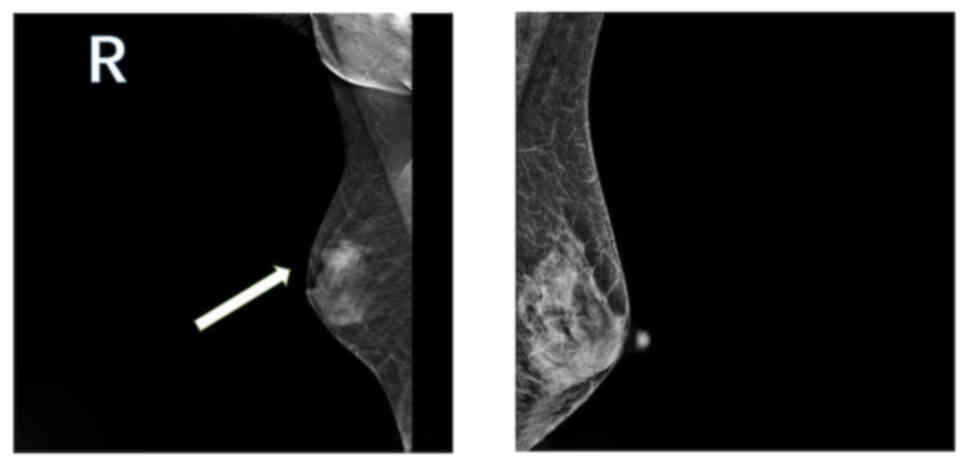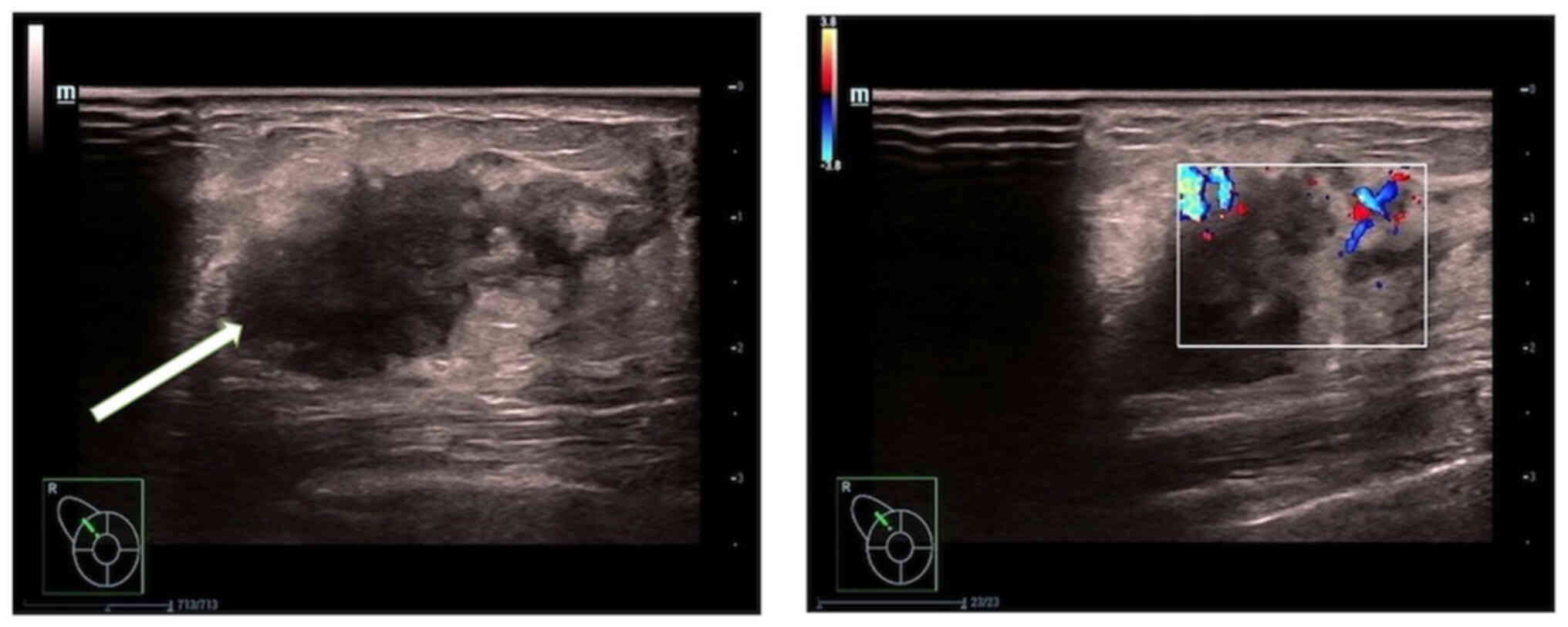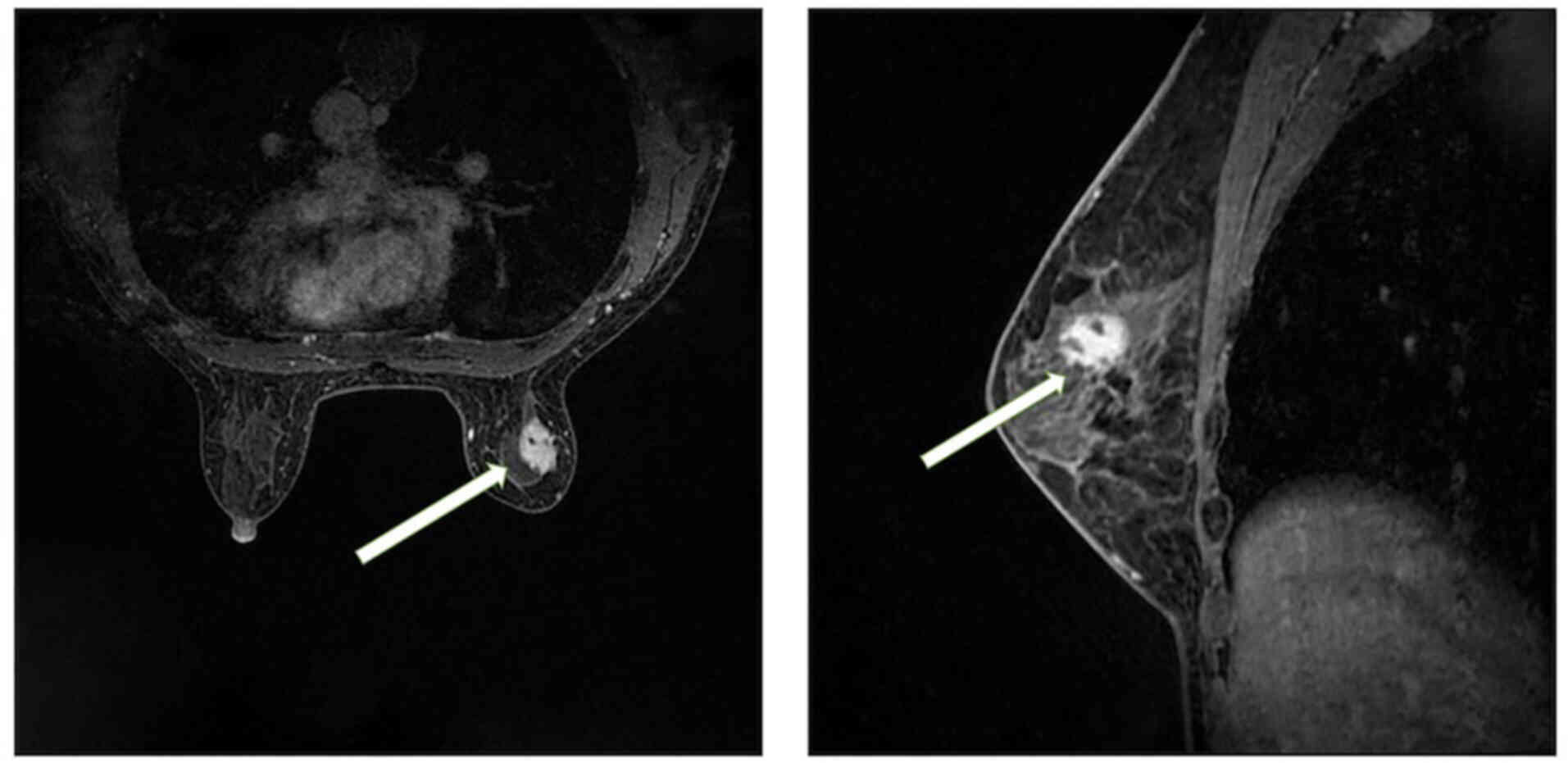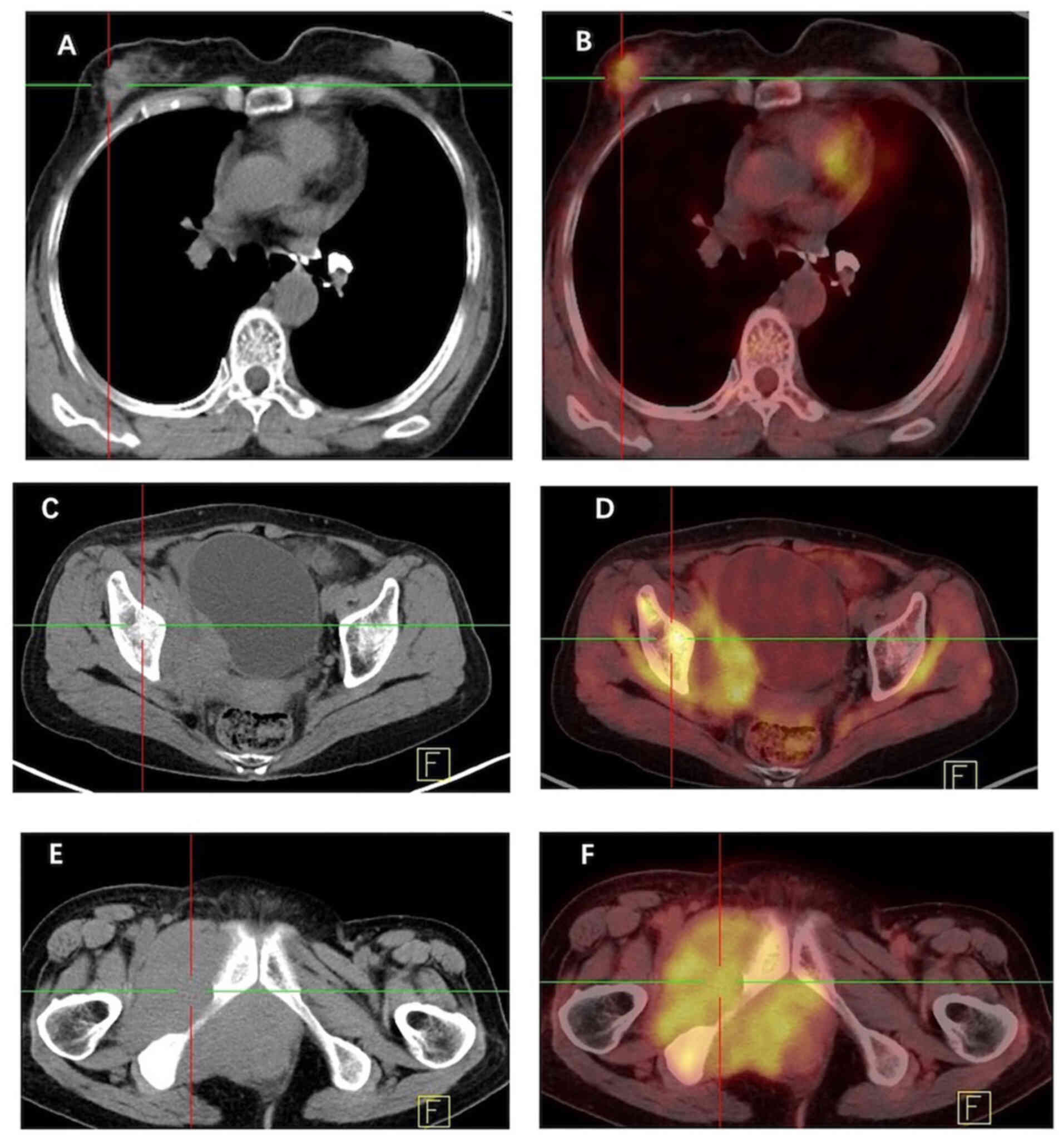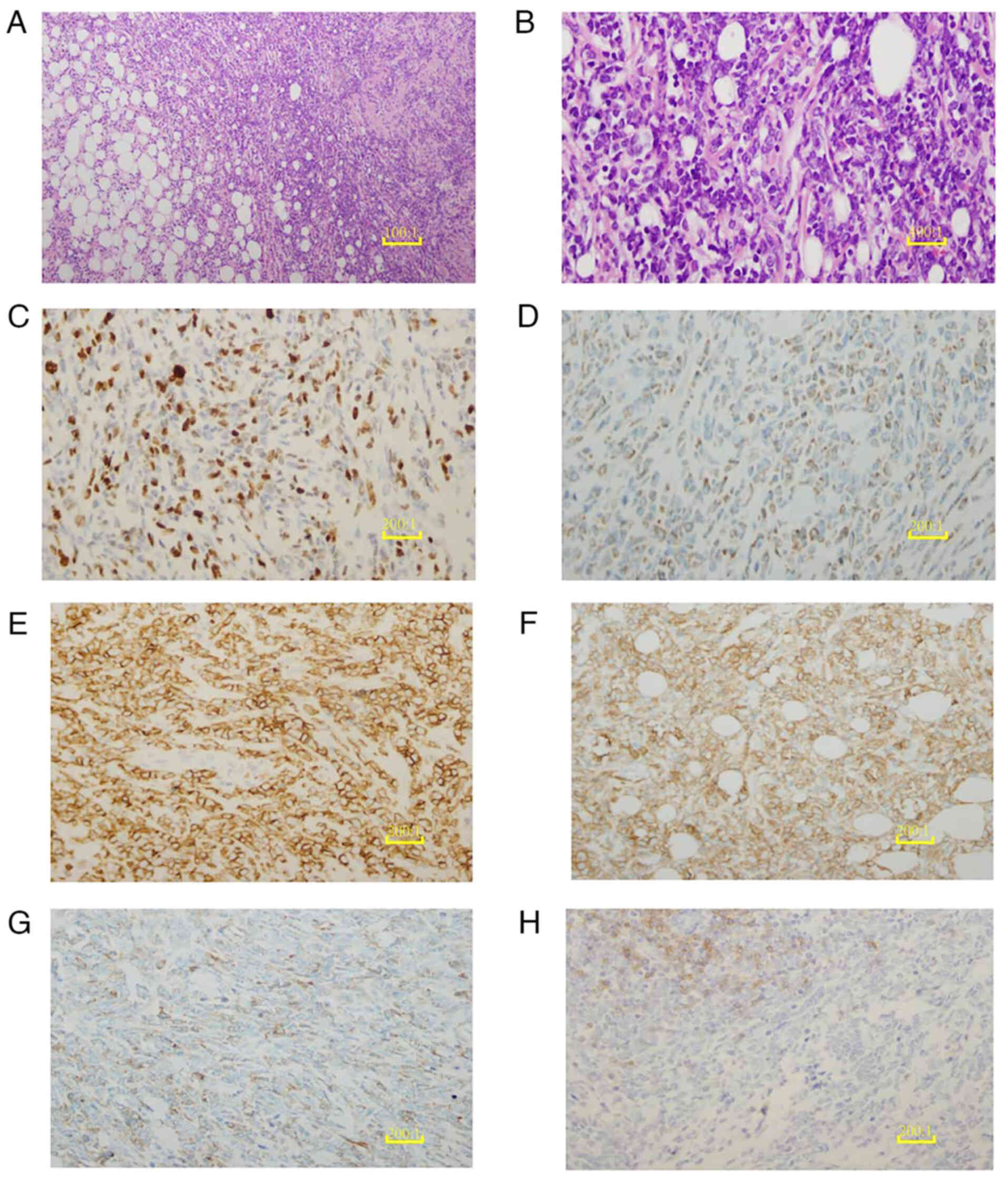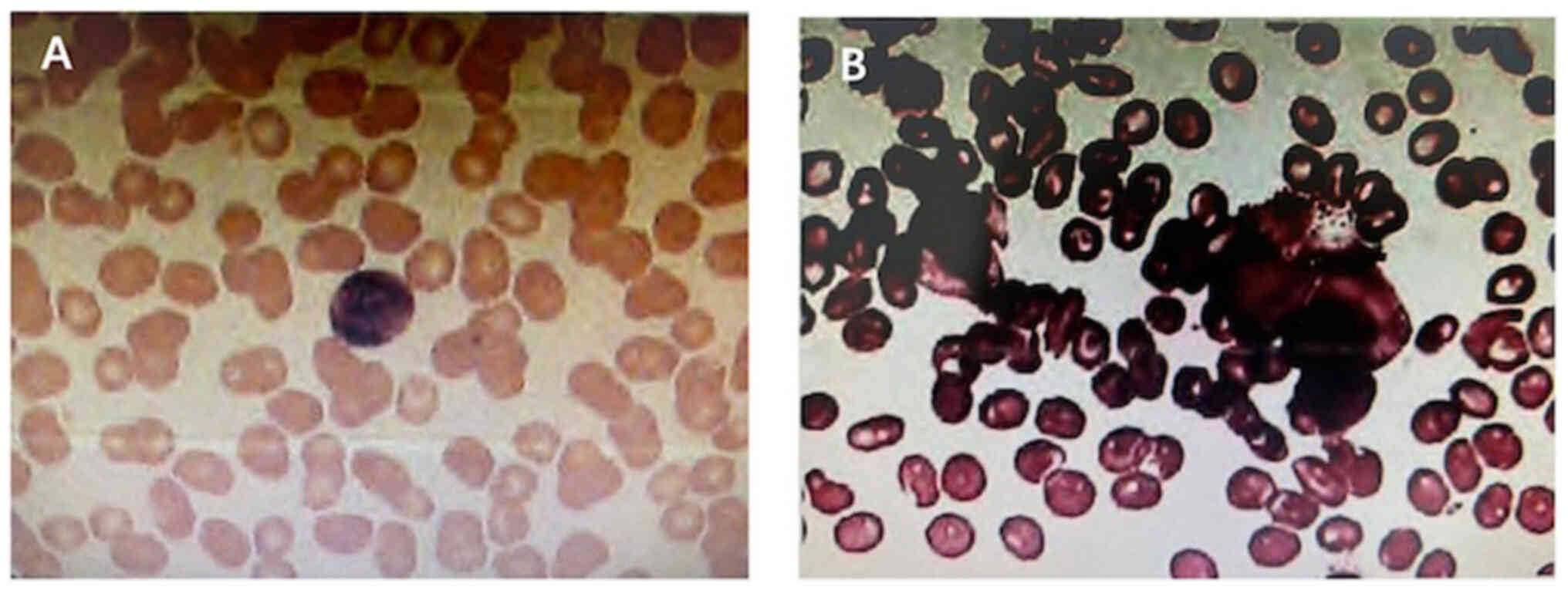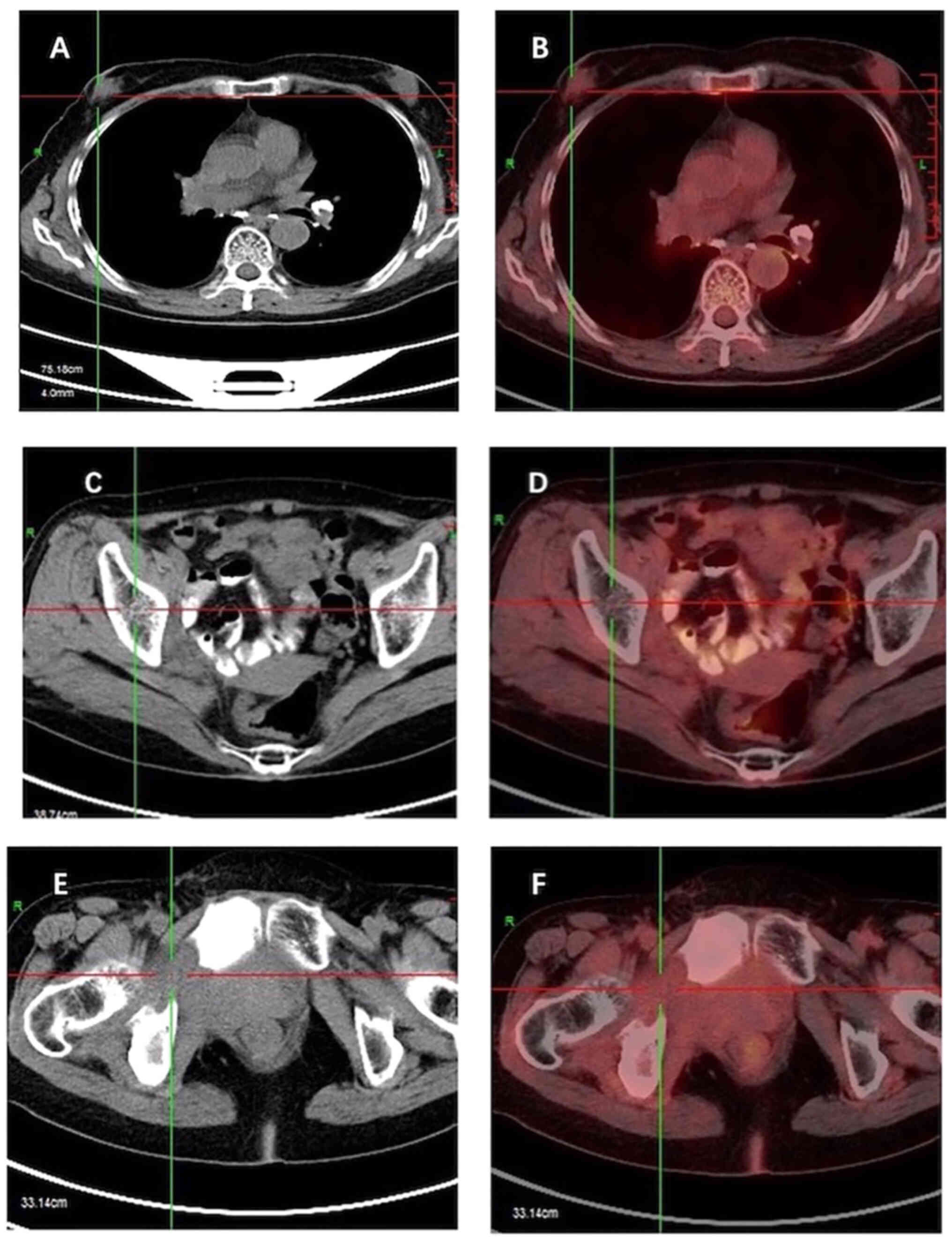|
1
|
Goyal G, Bartley AC, Patnaik MM, Litzow
MR, Al-Kali A and Go RS: Clinical features and outcomes of
extramedullary myeloid sarcoma in the United States: Analysis using
a national data set. Blood Cancer J. 7:e5922017. View Article : Google Scholar : PubMed/NCBI
|
|
2
|
Fitoz S, Atasoy C, Yavuz K, Gozdasoglu S,
Erden I and Akyar S: Granulocytic sarcoma. Cranial and breast
involvement. Clin Imaging. 26:166–169. 2002. View Article : Google Scholar : PubMed/NCBI
|
|
3
|
Ngu IW, Sinclair EC, Greenaway S and
Greenberg ML: Unusual presentation of granulocytic sarcoma in the
breast: A case report and review of the literature. Diagn
Cytopathol. 24:53–57. 2001. View Article : Google Scholar : PubMed/NCBI
|
|
4
|
Cunningham I: A clinical review of breast
involvement in acute leukemia. Leuk Lymphoma. 47:2517–2526. 2006.
View Article : Google Scholar : PubMed/NCBI
|
|
5
|
Yamauchi K and Yasuda M: Comparison in
treatments of nonleukemic granulocytic sarcoma: Report of two cases
and a review of 72 cases in the literature. Cancer. 94:1739–1746.
2002. View Article : Google Scholar : PubMed/NCBI
|
|
6
|
Kewalramani T, Zelenetz AD, Nimer SD,
Portlock C, Straus D, Noy A, O'Connor O, Filippa DA,
Teruya-Feldstein J, Gencarelli A, et al: Rituximab and ICE as
second-line therapy before autologous stem cell transplantation for
relapsed or primary refractory diffuse large B-cell lymphoma.
Blood. 103:3684–3688. 2004. View Article : Google Scholar : PubMed/NCBI
|
|
7
|
Miyazaki C, Shiozawa M, Koike R, Ogihara
K, Sasaki Y, Shiba S, Nishida S, Sakuragi M, Mizunuma H, Fujita T,
et al: Neoadjuvant chemotherapy for primary sarcoma of the breast:
A case report. J Med Case Rep. 13:2892019. View Article : Google Scholar : PubMed/NCBI
|
|
8
|
Wu L, Li X, Su J, Chang C, He Q, Zhang X,
Xu L, Song L and Pu Q: Effect of low-dose cytarabine,
homoharringtonine and granulocyte colony-stimulating factor priming
regimen on patients with advanced myelodysplastic syndrome or acute
myeloid leukemia transformed from myelodysplastic syndrome. Leuk
Lymphoma. 50:1461–1467. 2009. View Article : Google Scholar : PubMed/NCBI
|
|
9
|
National Comprehensive Cancer Network, .
NCCN clinical practice guidelines in oncology: Antiemesis. Version
3.2024. http://www.nccn.org/professionals/physician_gls/PDF/antiemesis.pdf
|
|
10
|
Grantham JT, Howell DM, Bacaj PJ, Coad JE
and Vos JA: Myeloid sarcoma of the bladder in the setting of
refractory anemia with excess blasts-2 (RAEB-2). W V Med J.
111:34–36. 2015.PubMed/NCBI
|
|
11
|
Nicosia L, Latronico A, Farina M, Bozzini
AC, Baratella P, Galimberti VE, Fiori S, Montesano M and Cassano E:
Myeloid sarcoma of the breast: A pathology that should not be
forgotten. Ecancermedicalscience. 14:11602020. View Article : Google Scholar : PubMed/NCBI
|
|
12
|
Thachil J, Richards RM and Copeland G:
Granulocytic sarcoma-a rare presentation of a breast lump. Ann R
Coll Surg Engl. 89:W7–W9. 2007. View Article : Google Scholar : PubMed/NCBI
|
|
13
|
Yu T, Xu G, Xu X, Yang J and Ding L:
Myeloid sarcoma derived from the gastrointestinal tract: A case
report and review of the literature. Oncol Lett. 11:4155–4159.
2016. View Article : Google Scholar : PubMed/NCBI
|
|
14
|
Viadana E, Bross ID and Pickren JW: An
autopsy study of the metastatic patterns of human leukemias.
Oncology. 35:87–96. 1978. View Article : Google Scholar : PubMed/NCBI
|
|
15
|
Naamo S, Naamo S, Sarker S, Vasconez M and
Froicu M: Breast manifestation of extramedullary myeloid sarcoma: A
case report. Radiol Case Rep. 17:4660–4665. 2022. View Article : Google Scholar : PubMed/NCBI
|
|
16
|
Amiraian D, McDonough M and Geiger X:
Bilateral myeloid sarcoma of the breast: A case report with
radiological and pathological correlation. Cureus.
14:e247312022.PubMed/NCBI
|
|
17
|
Ding Y, Xi D, Chen Y and Gu W: Myeloid
sarcoma of the breast as a first manifestation of acute myeloid
leukemia: A case report. Asian J Surg. 45:1622–1623. 2022.
View Article : Google Scholar : PubMed/NCBI
|
|
18
|
Huang C, Fei S, Yao J, Chen P, Luo J, Wang
Y, Li J and Wang W: Breast myeloid sarcoma presenting as a palpable
breast lump after allogeneic stem cell transplantation for acute
myelomonocytic leukemia: A rare case report. World J Surg Oncol.
19:2892021. View Article : Google Scholar : PubMed/NCBI
|
|
19
|
Varol E, Kiraz U, Guler SA, Vural Ç,
Gülbaş Z and Utkan NZ: Breast recurrence of acute myeloid leukemia
after bone marrow transplantation: A case report about myeloid
sarcoma of the breast. Eur J Breast Health. 17:292–295. 2021.
View Article : Google Scholar : PubMed/NCBI
|
|
20
|
Kim SJ and Kim WG: Sonographic features of
a myeloid sarcoma of the breast as a relapse of acute myeloid
leukemia after stem-cell transplantation: A case report. Am J Case
Rep. 20:612–619. 2019. View Article : Google Scholar : PubMed/NCBI
|
|
21
|
Wu HY, Liu L, Gu L and Luo YH: Clinical
characteristics and management of primary granulocytic sarcoma of
the breast: A case report. Medicine (Baltimore). 98:e166482019.
View Article : Google Scholar : PubMed/NCBI
|
|
22
|
Gomaa W and Ghanim A, Emam E, Bayoumi K
and Ghanim A: Primary myeloid sarcoma of the breast: A case report
and review of literature. J Microsc Ultrastruct. 6:212–214.
2018.PubMed/NCBI
|
|
23
|
Uchida E, Watanabe K, Oshikawa G,
Sakashita C, Kurosu T, Fukuda T, Arai A, Murakami N, Miura O and
Yamamoto M: Refractory primary myeloid sarcoma of the breast with
MLL-AF9 rearrangement. Rinsho Ketsueki. 57:47–51. 2016.PubMed/NCBI
|
|
24
|
Stewart RL, Dell CM and Samayoa L: Myeloid
sarcoma of the breast misdiagnosed as poorly differentiated mammary
carcinoma with lobular features. Breast J. 21:192–193. 2015.
View Article : Google Scholar : PubMed/NCBI
|
|
25
|
Nalwa A, Nath D, Suri V, Jamaluddin MA and
Srivastava A: Myeloid sarcoma of the breast in an aleukemic
patient: A rare entity in an uncommon location. Malays J Pathol.
37:63–66. 2015.PubMed/NCBI
|
|
26
|
Gündüz E, Akay MO, Karagülle M and Ak IS:
isolated granulocytic sarcoma of the breast after allogeneic stem
cell transplantation: A rare involvement also detected by
18FDG-PET/CT. Turk J Haematol. 31:88–91. 2014. View Article : Google Scholar : PubMed/NCBI
|
|
27
|
Fu J and Luo J: Granulocytic sarcoma of
the breast in acute myeloid leukemia: Two case reports. Oncol Lett.
7:145–147. 2014. View Article : Google Scholar : PubMed/NCBI
|
|
28
|
Avni B and Koren-Michowitz M: Myeloid
sarcoma: Current approach and therapeutic options. Ther Adv
Hematol. 2:309–316. 2011. View Article : Google Scholar : PubMed/NCBI
|
|
29
|
Li JM, Liu WP, Zhang MH, Wei X, Gu JM, Han
AJ, Wu WQ and Chen XY: Clinicopathologic and immunophenotypic
analysis of myeloid sarcoma. Zhonghua Bing Li Xue Za Zhi.
35:606–611, (In Chinese). PubMed/NCBI
|
|
30
|
Pileri SA, Ascani S, Cox MC, Campidelli C,
Bacci F, Piccioli M, Piccaluga PP, Agostinelli C, Asioli S, Novero
D, et al: Myeloid sarcoma: Clinico-pathologic, phenotypic and
cytogenetic analysis of 92 adult patients. Leukemia. 21:340–350.
2007. View Article : Google Scholar : PubMed/NCBI
|
|
31
|
Estey EH: Acute myeloid leukemia: 2019
update on risk-stratification and management. Am J Hematol.
93:1267–1291. 2018. View Article : Google Scholar : PubMed/NCBI
|
|
32
|
Traweek ST, Arber DA, Rappaport H and
Brynes R: Extramedullary myeloid cell tumors. An
immunohistochemical and morphologic study of 28 cases. Am J Surg
Pathol. 17:1011–1019. 1993. View Article : Google Scholar : PubMed/NCBI
|
|
33
|
Audouin J, Comperat E, Le Tourneau A,
Camilleri-Broët S, Adida C, Molina T and Diebold J: Myeloid
sarcoma: Clinical and morphologic criteria useful for diagnosis.
Int J Surg Pathol. 11:271–282. 2003. View Article : Google Scholar : PubMed/NCBI
|
|
34
|
Mourad W, Kfoury H and Al Husseini H: The
value of CD34, myeloperoxidase and chloroacetate esterase (Leder)
stain in the diagnosis of granulocytic sarcoma. Ann Saudi Med.
21:287–291. 2001. View Article : Google Scholar : PubMed/NCBI
|
|
35
|
He J, Zhu L, Ye X, Li L, Zhu J, Zhang J,
Xie W, Shi J, Zheng W, Wei G, et al: Clinical characteristics and
prognosis of nonleukemic myeloid sarcoma. Am J Med Sci.
347:434–438. 2014. View Article : Google Scholar : PubMed/NCBI
|
|
36
|
Florou D, Katsara M, Feehan J, Dardiotis E
and Apostolopoulos V: Anti-CD20 agents for multiple sclerosis:
Spotlight on ocrelizumab and ofatumumab. Brain Sci. 10:7582020.
View Article : Google Scholar : PubMed/NCBI
|
|
37
|
Huang XE, Li YJ and Zhou XD: Granulocytic
sarcoma of the breast: A case report. Oncol Lett. 10:2447–2449.
2015. View Article : Google Scholar : PubMed/NCBI
|
|
38
|
Widhalm G, Dietrich W, Müllauer L,
Streubel B, Rabitsch W, Kotter MR, Knosp E and Roessler K: Myeloid
sarcoma with multiple lesions of the central nervous system in a
patient without leukemia. Case report. J Neurosurg. 105:916–919.
2006. View Article : Google Scholar : PubMed/NCBI
|
|
39
|
Tsimberidou AM, Kantarjian HM, Wen S,
Keating MJ, O'Brien S, Brandt M, Pierce S, Freireich EJ, Medeiros
LJ and Estey E: Myeloid sarcoma is associated with superior
event-free survival and overall survival compared with acute
myeloid leukemia. Cancer. 113:1370–1378. 2008. View Article : Google Scholar : PubMed/NCBI
|
|
40
|
Védy D, Muehlematter D, Rausch T, Stalder
M, Jotterand M and Spertini O: Acute myeloid leukemia with myeloid
sarcoma and eosinophilia: Prolonged remission and molecular
response to imatinib. J Clin Oncol. 28:e33–e35. 2010. View Article : Google Scholar : PubMed/NCBI
|
|
41
|
Spak DA, Plaxco JS, Santiago L, Dryden MJ
and Dogan BE: BI-RADS((R)) fifth edition: A summary of changes.
Diagn Interv Imaging. 98:179–190. 2017. View Article : Google Scholar : PubMed/NCBI
|



